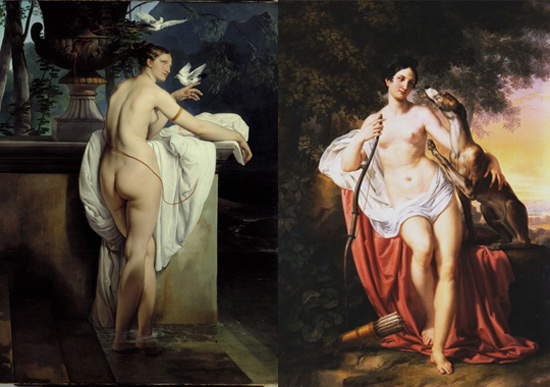There are good margins of certainty to say that, in this day and age, we would all have ignored the name of Carlotta Chabert, a mid-nineteenth-century ballerina, were it not for one specific circumstance: the fact that she was the mistress of a wealthy patron of Francesco Hayez (1791 - 1882). And there is little, if any, further information we know about the woman. Not least because Count Girolamo Malfatti, the much-talked-about aristocrat from Trentino who fell in love with her, tried not to flaunt his liaison, which might have been judged unseemly and wholly inappropriate for a gentleman of his rank: we are, after all, in an era in which appearances needed to be saved as much as possible. Nevertheless, the count had the idea of paying homage to his lover with a painting to be commissioned from the illustrious Venetian artist, and to obtain it he was even willing to pay dearly for it: the sum the aristocrat paid to Hayez was seven hundred marenghi, a sum that could guarantee anyone to lead a decent life for a whole year.
 |
| The Venus Callipigia |
 |
| Francesco Hayez, Venus Joking with Two Doves (Portrait of Ballerina Carlotta Chabert) (1830; oil on canvas, 183 x 137 cm; Rovereto, MART) |
Purists could not tolerate the sight of such a painting, which was considered desecratory to the classical ideal of beauty: the woman’s proportions were not considered harmonious, since the lower part of her body was deemed disproportionate to the upper, and her manner was judged too procrustean. It is Hayez himself, in his Memoirs, who recalls the criticisms that were made of his painting: I must confess that if from the color side perhaps this figure was successful, in form it did not have that nobility desired in the queen of beauty, the cause was the model, which although it was not really defective, still if I had tried to improve it I would have succeeded to my greater satisfaction: but the respect which I have for the true took away my daring to improve it behind the study which I had previously made of Greek things: with all this he had not thought to deserve me such bitter criticism that he hurled himself at me, describing my Venus as “the foulest woman of the vulgar.” In 1835 another painter, Pelagio Palagi (1775 - 1860), is said to have portrayed Carlotta Chabert as the goddess Diana, in a painting also made for Girolamo Malfatti (but which never reached the count): a comparison with Hayez’s work unequivocally reveals the modernity of the latter’s Venus.
 |
| Paintings by Francesco Hayez and Pelagio Palagi in comparison (right: Pelagio Palagi, Diana (Portrait of Carlotta Chabert) (1835; oil on canvas, 217 x 143 cm; Bologna, MAMbo) |
A fundamental concept emerges from Hayez’s words: respect for truth. The painter does not intend to seek ideal beauty: in this willingness of his to represent, even through the filter of mythology, a real, sensual and palpitating body on canvas, lies the modernity of the great Romantic artist. And in fact, not only criticism had to receive the work: the Romantics who frequented Braid’s circles supported the painter, reminding their adversary classicists that the operation Hayez intended to carry out, though original, drew inspiration from illustrious precedents. Indeed, the sensuality of Hayez’s Venus was the same that characterized the Venuses of Titian, another artist who did not fail to model himself on women of easy virtue for his goddesses. And we must not forget that the Romantics were pushing for amodern art that would begin to move away from the classical tradition to meet the new demands for truth in paintings: those to which, as we have seen, Hayez’s Venus responded.
And the patron? How did he react to the controversy stirred by the painting in Milan? Probably, the scandal remained confined to Lombardy, but the complicity between the aristocrat and the painter must have caused the artist to report to the count, perhaps even amused, what happened at the exhibition. Certainly, the scandal did not at all undermine the relationship between the two, quite the contrary: the following year, Girolamo Malfatti commissioned Hayez to paint a new painting with a mythological subject. And certain, too, is the fact that soon the world of academies (and art in general) forgot about Venus-Carlotta Chabert, which was rediscovered only in the early twentieth century, when critic Nino Barbantini, in 1923, included the work in the “Exhibition of the Venetian Portrait of the Nineteenth Century,” considering it one of the best portraits of the nineteenth century: perhaps, the work owes its fame to this exhibition.
Today, we look at Francesco Hayez’s Venus as one of the greatest masterpieces of eroticism in art, as a painting that denotes an interesting blend of modernity and classicism, and above all as one of the most innovative works of its time, confirming Hayez’s exceptional inventiveness, as well as his great gifts in the rapresentation of the female nude, of which he was an undisputed master. And the echo of the controversy that accompanied the painting when it was shown seems to have died down completely today: we are left with the depiction of a woman, beautiful in her realistic features and provocative sensuality.
Warning: the translation into English of the original Italian article was created using automatic tools. We undertake to review all articles, but we do not guarantee the total absence of inaccuracies in the translation due to the program. You can find the original by clicking on the ITA button. If you find any mistake,please contact us.